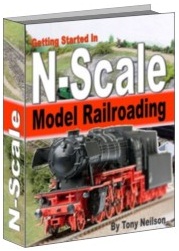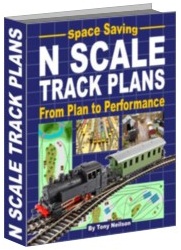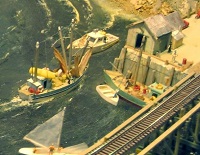|
Guest Contributor: Malcolm
Abbott
If you have recently
acquired an interest in making a model railroad and all its scenery from
scratch, then you must know everything about the size and shapes that you
intend to use. Before you randomly pick some scale for your model trains and
its surrounding scenery, thoroughly research the possibilities. This way, you
won’t have to face any difficulties in the middle of your
project.
So what is N scale scenery?
Here is a short guide for you.
N Scale
Models
Considered to be one of the
most popular model railway scale, N scale varies from size 1:148 to 1:160.
Whatever the range maybe, the gauge or the distance between the rails is 0.354
inches or 9 mm. The reason so many people use N scale is that everything in it
is smaller in size. The HO scale comparatively, takes up a lot more space. With
N scale the tracks of the trains can be longer, but occupy same amount of
space.
If you are among those who
like long, curving trains with detailed terrains and miniature scenery, then N
scale is the one for you. You can make lots and lots of surrounding structures
like tunnels and bridges where your rails pass over or through. Making N scale
scenery (as with all other model train scales) requires dedication and lots of
creativity.
Making N Scale
Scenery
As far as scenery is
concerned, you have two options. Either buy readymade objects or make them
yourself. Readymade scenery and structures is not only expensive, it can be
relatively boring. You often don’t get to do anything except for inserting
everything in its right place. Where’s the fun in that?! It’s much more
exciting to come up with your own methods, experimenting with unique things to
make your own, hard worked scenery. So how can you begin?
First determine your theme
and buy trains and its tracks according to your chosen scale or theme. Then
decide how detailed you want your model train layout to be. Will it involve
many tunnels, backgrounds, stations, signboards, houses, mountain ranges,
rivers and other features? Here are some easy tricks to make a few of these
things:
Grass
One easy way to make grass
is to collect sawdust and dye or add food colors to make it green or brown. You
can color it brown, orange, or yellow in Autumn/Fall tones, or make it a light
green to scatter it around lakes and ponds.
Tunnels
For tunnels, one of the
easiest methods is to use beaded Styrofoam. You can cut it up according to N
scale scenery size and then use it. When painting, use concrete-colored wash
and then spray the inside with some gray or black paint to make it look more
realistic. Depending on what era you display, you can add stains of smoke by
spray painting the inside and tunnel entrance a dark gray or black
color.
Telephone
Poles
You can make telephone
poles using match sticks. All you would have to do is paint them carefully. If
you are going with a
yesteryear theme, then you can even use thin
wooden sticks as poles. Also, make sure when you add telephone poles to your
layout, you also add wires to them. This gives a feeling or originality. You
can use thin, flexible wires and cut them into as long or as short as need. The
same can be done with electric poles.
The important thing is to
thoroughly research the numerous possibilities when creating N scale scenery
for your model railroad layout.
|
Recommended
Model Train Resources

Getting
Started In
N Scale Model Railroading
Click Here To Watch
Video

Space
Saving
N SCALE TRACK PLANS
From Plan To Performance
Click Here To Watch
Video

N Scale
Locomotives
N Gauge Railway
Layouts
N Gauge
Buildings
N Gauge Model Railway
Layouts
N Scale
Scenery
N Gauge Track
Plans
|

